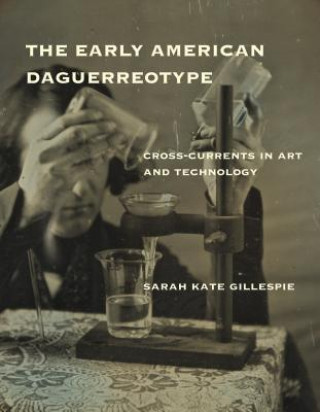
Kód: 02933297
Early American Daguerreotype
Autor Gillespie, Sarah Kate (Curator of American Art, University of Georgia)
The daguerreotype, invented in France, came to America in 1839. By 1851, this early photographic method had been improved by American daguerreotypists to such a degree that it was often referred to as "the American process." The d ... celý popis
- Jazyk:
 Angličtina
Angličtina - Väzba: Pevná
- Počet strán: 232
Nakladateľ: MIT Press Ltd, 2016
- Viac informácií o knihe

10.22 €
Bežne: 11.64 €
Ušetríte 1.43 €
Dostupnosť:
50 % šanca Máme informáciu, že by titul mohol byť dostupný. Na základe vašej objednávky sa ho pokúsime do 6 týždňov zabezpečiť.
Máme informáciu, že by titul mohol byť dostupný. Na základe vašej objednávky sa ho pokúsime do 6 týždňov zabezpečiť.Prehľadáme celý svet
Mohlo by sa vám tiež páčiť
-

David Bowie Is
44.33 € -9 % -

Sanctuary City
76.22 €
Darčekový poukaz: Radosť zaručená
- Darujte poukaz v ľubovoľnej hodnote, a my sa postaráme o zvyšok.
- Poukaz sa vzťahuje na všetky produkty v našej ponuke.
- Elektronický poukaz si vytlačíte z e-mailu a môžete ho ihneď darovať.
- Platnosť poukazu je 12 mesiacov od dátumu vystavenia.
Informovať o naskladnení knihy
Zadajte do formulára e-mailovú adresu a akonáhle knihu naskladníme, zašleme vám o tom správu. Postrážime všetko za vás.
Viac informácií o knihe Early American Daguerreotype
Nákupom získate 26 bodov
 Anotácia knihy
Anotácia knihy
The daguerreotype, invented in France, came to America in 1839. By 1851, this early photographic method had been improved by American daguerreotypists to such a degree that it was often referred to as "the American process." The daguerreotype -- now perhaps mostly associated with stiffly posed portraits of serious-visaged nineteenth-century personages -- was an extremely detailed photographic image, produced though a complicated process involving a copper plate, light-sensitive chemicals, and mercury fumes. It was, as Sarah Kate Gillespie shows in this generously illustrated history, something wholly and remarkably new: a product of science and innovative technology that resulted in a visual object. It was a hybrid, with roots in both fine art and science, and it interacted in reciprocally formative ways with fine art, science, and technology. Gillespie maps the evolution of the daguerreotype, as medium and as profession, from its introduction to the ascendancy of the "American process," tracing its relationship to other fields and the professionalization of those fields. She does so by recounting the activities of a series of American daguerreotypists, including fine artists, scientists, and mechanical tinkerers. She describes, for example, experiments undertaken by Samuel F. B. Morse as he made the transition from artist to inventor; how artists made use of the daguerreotype, both borrowing conventions from fine art and establishing new ones for a new medium; the use of the daguerreotype in various sciences, particularly astronomy; and technological innovators who drew on their work in the mechanical arts. By the 1860s, the daguerreotype had been supplanted by newer technologies. Its rise (and fall) represents an early instance of the ever-constant stream of emerging visual technologies
 Parametre knihy
Parametre knihy
10.22 €
- Celý názov: Early American Daguerreotype
- Podnázov: Cross-Currents in Art and Technology
- Autor: Gillespie, Sarah Kate (Curator of American Art, University of Georgia)
- Jazyk:
 Angličtina
Angličtina - Väzba: Pevná
- Počet strán: 232
- EAN: 9780262034104
- ISBN: 0262034107
- ID: 02933297
- Nakladateľ: MIT Press Ltd
- Hmotnosť: 780 g
- Rozmery: 238 × 186 × 24 mm
- Dátum vydania: 12. February 2016
Obľúbené z iného súdka
-

Dune
9.61 € -21 % -

Haunting Adeline
30.67 € -

Berserk Deluxe Volume 2
47.88 € -5 % -

White Nights
4.14 € -11 % -

Powerless
12.54 € -2 % -

Atomic Habits
17.40 € -24 % -

Dune Messiah
9.10 € -18 % -

Berserk Deluxe Volume 3
53.85 € -

One Day
10.62 € -11 % -

Berserk Deluxe Volume 1
51.93 € -

Iron Flame
16.29 € -18 % -

Surrounded by Idiots
11.13 € -25 % -

Harry Potter and the Prisoner of Azkaban (Minalima Edition)
41.80 € -

Gravity Falls Journal 3
21.86 € -

Heaven Official's Blessing: Tian Guan Ci Fu (Novel) Vol. 1
21.76 € -

The Creative Act
26.11 € -5 % -

Dune
9.81 € -31 % -

Hunting Adeline
31.88 € -

A Little Life
17.50 € -

Children of Dune
11.43 € -

Heaven Official's Blessing: Tian Guan Ci Fu (Novel) Vol. 2
23.38 € -

Bungo Stray Dogs, Vol. 8 (light novel)
16.90 € -

Percy Jackson and the Olympians 5 Book Paperback Boxed Set
47.27 € -

Solo Leveling, Vol. 1
21.66 € -

The Prisoner's Throne
9.41 € -21 % -

Court of Thorns and Roses
9.51 € -20 % -

Cry Baby Coloring Book
11.84 € -

Fourth Wing
14.87 € -24 % -

Icebreaker
9.41 € -15 % -

Berserk Deluxe Volume 6
47.88 € -5 % -

Avatar, the Last Airbender: The Kyoshi Novels (Box Set)
41.50 € -

The 48 Laws of Power
26.21 € -3 % -

House of Leaves
22.47 € -24 % -

Twisted Lies
9.81 € -17 % -

Dune Messiah
12.54 € -12 % -

No Longer Human
16.80 € -

48 Laws Of Power
17.81 € -24 % -

Twisted Games
9.71 € -24 % -

Caraval Paperback Boxed Set
43.12 € -

Solo Leveling, Vol. 2
19.23 € -9 % -

Open Circuits
41.50 € -

Berserk Deluxe Volume 5
53.24 € -

Heaven Official's Blessing: Tian Guan Ci Fu (Novel) Vol. 3
16.90 € -20 % -

Berserk Deluxe Volume 4
51.62 € -23 % -

Court of Mist and Fury
9.41 € -21 % -

SOLO LEVELING V08
21.66 € -

English File Upper Intermediate Multipack A (4th)
19.43 € -12 % -

CHAINSAW MAN V14
11.33 € -12 % -

Before the Coffee Gets Cold
9.71 € -24 %
Osobný odber Bratislava a 2642 dalších
Copyright ©2008-24 najlacnejsie-knihy.sk Všetky práva vyhradenéSúkromieCookies


 21 miliónov titulov
21 miliónov titulov Vrátenie do mesiaca
Vrátenie do mesiaca 02/210 210 99 (8-15.30h)
02/210 210 99 (8-15.30h)